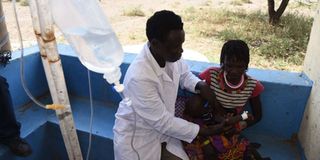Malaria ravages villages in Tiaty amid drugs shortage

Nurse William Loremoi (in white lab coat) attends to patients at Riong’o Health Centre in Tiaty Sub-county on October 18. Cases of malaria are on the rise in the area.
What you need to know:
- Patients raised concerns over the long queues and the safety of the critically ill.
- There is a shortage of mosquito nets and locals were relying on those given to them last year at the height of a similar outbreak.
An upsurge of malaria cases has been reported in several villages in Tiaty East Sub-county, with hard-hit facilities reeling under a biting shortage of drugs.
Among the worst-hit villages are Akwichatis, Riong’o, Silale, Nasorot, Naudo, Chemukutan, Narang’ule, Natan, Napeikore, Lokaukon, Paka, Chemoril,Nalekat and Nasiwialet.
When the Nation visited some of the facilities in the areas, patients, a majority of them children languished in long queued, with the severely ill having to be given first aid.
At Riong’o dispensary in Silale ward, a frail, weak and dehydrated five-year-old girl was hooked on to a drip at the waiting bay. She and her parents had travelled for two straight days from Silale village, more than 35 kilometres away.
Jaundiced eyes, swollen legs due to anaemia, and seizures caused by severe fever are common symptoms. Patients who are too sick sleep on the bare ground under trees.
Mr William Loremoi, a nurse at the facility, said he had no drugs to give them. The lack of mosquito nets, scarcity of facilities, poor roads and unreliable mobile network has also worsened the situation, he said. Mr Loremoi revealed that the cases started in August and the numbers have been increasing steadily.
“Young children and expectant mothers are the worst affected. By the time they arrive here, many are severely ill and need emergency care,” he said.
Anti-malaria drugs
“Sometimes, the number of patients is overwhelming to an extent we run short of anti-malaria drugs and they have to wait because we are forced to source them from other facilities such as Chemolingot and Tangulbei, tens of kilometres away,” Mr Loremoi added.
He said handling emergency cases is a challenge because patients depend on one ambulance which is stationed at Chemolingot Sub-county Hospital, some 34 kilometres away.
“The hospitals are few and far between. Villagers are forced to treat their sick using herbal remedies. If this doesn’t work, they are forced to walk long distances to the dispensary and, by the time they get here, the situation has deteriorated and patients may need specialised care such as blood transfusion which we don’t offer,” said the nurse.
Most patients travel for an average of three days. The nearest after Riong’o is Akwichatis, more than 50 kilometres away.
According to Mr Loremoi, the numbers have been increasing exponentially such that, out of the approximately 40 patients who seek treatment daily, half of them have malaria. Records at the facility reveal that more than 200 patients in the area have tested positive for malaria in the past one month.
“We attend to at least 40 patients daily and out of the number, 15 to 20 patients turn positive with a majority being young children. The number has however increased since the upsurge started close to two months ago,” said Mr Loremoi.
Long queues
The situation was no different at Akwichatis dispensary, where women and children lay suffering under trees as they waited for their turn to be served. Patients raised concerns over the long queues and the safety of the critically ill.
Tiaty East Sub-county health services coordinator Joseph Nakopir acknowledged that there has been a malaria upsurge in the region since August and that the county lacks enough anti-malaria drugs.
“The hotspot areas are Ring’o, Akwichatis and Chemoril. However, there is no cause for alarm because we managed to source some drugs from Marigat Sub-County Hospital and no lives have been lost,” said Mr Nakopir.
He, however, noted that there is a shortage of mosquito nets and locals were relying on those given to them last year at the height of a similar outbreak.
Last year, more than 10 people died of malaria, a majority of them children under the age of five. The most affected areas were Gulel, Atirir, Kapau, Akoret, Kongor, Chesotim, Kaghat and Tayier villages. In 2017, close to 20 children and expectant women lost their lives.
In Akoret division, there isn’t a single operational health facility in the entire region — one of the hot spot areas — with locals forced to walk for more than 100 kilometres to Chemolingot Sub-County Hospital or Kapedo Health Centre, 45 kilometres away, which cannot be accessed due to the runaway insecurity.





